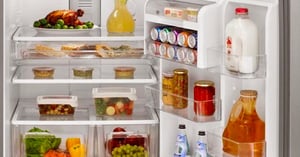Shopping for appliances can be overwhelming. There are new products with new features on the market every day — when searching amazon.com for “refrigerators” there are no less than 250,000 products. We can help you narrow it down and find the right energy-efficient fridge for you!
What type of fridge do you want?
- Bottom Freezer: Bottom freezer refrigerators tend to be more expensive than other types. Their big advantage is that all your fresh food is very easily accessible. If you use frozen products a lot, this might not be the fridge for you since you’d have to bend to get something from the freezer.
- Top Freezer: If you choose a top freezer fridge, the drawers with your fresh produce will be all the way down at the bottom. If you like to cook with fresh produce a lot, that means a lot of bending. Frozen food and ice will be easily accessible though.
- Side-by-Side: Side-by-Side fridges make it easy to access both the fridge and the freezer without bending. The big disadvantage is that both compartments are very narrow — you might find it difficult to store bigger item such as trays in this type of fridge.
How much capacity do you need? How much space do you have?
To decide how big your fridge should be, you first need to figure out how much space you have. Make sure you measure the height, width and depth that you have available. Also take into consideration the different types of doors and how they will fit into your kitchen: Do you want a popular French door fridge or would a door that opens in only one direction work better for you?
The right capacity is more difficult to find and depends on many factors. How many people are living in your household? Are you using more fresh or more frozen products? How much space for oversized item and beverage containers do you need? Are you buying milk by the gallon? You don’t want a fridge that’s too small of course, but if you end up with a fridge that’s much bigger than needed, you’ll waste a lot of energy and space.
What kind of installation?
There are two options for installation type: Free-standing and built-in. Free-standing fridges are less expensive and can easily be moved. Built-in fridges are easier to incorporate in the design of the kitchen; they are more expensive and have to be installed professionally.
How energy-efficient should the fridge be?
Unlike other devices, your fridge will be running 24 hours a day, 365 days a year and it’s a good idea to pick one that is energy-efficient. If you compare two fridges with about the same capacity, an energy-efficient model like Electrolux fridge will cost you about $830 to run during its lifetime (~12 years). A non-energy-efficient one costs about $1,145 to run over 12 years. Looking at the bigger picture, those numbers make a big difference: If all fridges sold in the US this year were the highly efficient Electrolux fridge, we would save a total of 5.2 billion tons of CO2, $1.3 Billion in electricity cost, which is equivalent to 639,014 homes’ electricity use.

